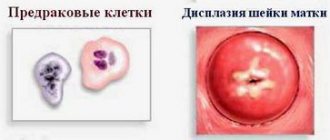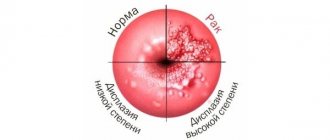Radio wave destruction of the cervix is considered one of the most effective treatment methods in modern gynecology. This non-contact technique is characterized by low trauma and a relatively short recovery period.
Destruction by radio waves is used for various gynecological pathologies and conditions. In particular, the tactics are successful in eliminating papillomas, endometriosis, and genital nevi. In most cases, the use of radio wave destruction of the cervix is carried out in relation to erosion.
Ectopia or cervical erosion is a benign background process that means the appearance of a spot on the cervix. It is noteworthy that the defect occurs in the area of the cervix, which is adjacent to the vagina.
When examining the cervix, only the pink squamous epithelium of the vaginal area, which is lined with flat multilayered cells, is visualized. Inside the cervix there is a cervical canal, which, with the help of mucus produced, protects the sterile uterine cavity from infection. The cervical canal contains single-layer cylindrical cells on its surface, giving it a reddish tint and velvety appearance.
Cervical erosion can occur in women of any age. Among the reasons for the development of a defect in the cervical epithelium, experts identify:
- trauma to the cervix, leading to ectropion and erosion;
- infections;
- early sexual life;
- lack of monogamy;
- decreased immunity;
- age factor;
- hormonal fluctuations;
- taking certain medications;
- inadequate contraception.
Certain reasons determine the appearance of a particular type of erosion.
- Congenital ectopia is the replacement of squamous epithelium with columnar epithelium. The defect is temporary and is associated with the intrauterine covering of the cervix with cells of the cervical canal. By the end of puberty, congenital ectopia usually disappears.
- True erosion appears when the cervix is negatively affected by various unfavorable factors, which leads to a violation of its integrity. The resulting wound heals on its own within a few days.
- Acquired ectopia or pseudo-erosion is a consequence of improper restoration of the cervical epithelium. In this case, true erosion is covered with cells of the cervical canal. Pseudo-erosion, like a true defect, is usually accompanied by an inflammatory process.
Erosion usually has no symptoms. The existing clinical picture, as a rule, indicates the presence of concomitant diseases. It is known that erosion usually occurs simultaneously with other gynecological pathologies. In this situation, a woman can pay attention to the following symptoms:
- discharge indicating an inflammatory process;
- bleeding and acyclic spotting;
- pain syndrome;
- disorders associated with cycle duration.
Women should remember that the only symptom of possible erosion is mucous or contact discharge. The appearance of a large amount of mucus indicates activation of the glands of the cylindrical cells. After sexual intercourse or examination of the cervix with a gynecological instrument, minor bleeding, called contact, may occur.
To diagnose ectopia, it is necessary to conduct an examination, which includes:
- visual examination of the cervix;
- colposcopy;
- biopsy;
- flora smear, bacterial culture, oncocytology, PCR method for diagnosing STIs.
Treatment of ectopia is carried out according to indications. The congenital defect requires dynamic monitoring. If there is an inflammatory process, it is eliminated through medications. Pseudo-erosion requires cauterization, during which the defect is removed.
Cauterization of an erosive spot can be carried out using various tactics. In modern gynecology, destruction of the cervix by radio waves is considered the most effective and gentle method of non-contact exposure.
Description of the drug Solkovagin
The drug Solkovagin (pictured) is intended for the treatment of benign lesions of the soft tissue of the cervix. When using the drug, different effects on different epithelial structures are observed. When the medication is applied to the columnar epithelium and subepithelial stroma, they are devitalized and fixed. The neoplasm loses its viability and no longer grows.
Multilayer cellular structures of squamous epithelium (healthy tissue of the cervix) are not exposed to the negative effects of the medication, therefore, after treatment of the cervix with Solkovagin, they remain undamaged. It only takes a few minutes to fix the affected areas and the tissue turns yellowish-white or gray.
This phenomenon is not typical for acid cauterization; the necrotic area remains in place, but it is not active; a protective layer is formed on its surface, which peels off in a few days as new cells grow and form underneath it.
Attention! A definite advantage of the drug Solkovagin is that its activity manifests itself only at the site of application. The active substances are not absorbed into the systemic circulation and do not provoke adverse reactions.
Solkovagin is a clear solution with a specific odor. It consists of the following components:
- nitric acid 70%;
- acetic acid 99%;
- oxalic acid dihydrate;
- zinc nitrate hexahydrate.
Purified water is used as an auxiliary component to ensure that a solution of the required concentration is obtained.
Indications and contraindications for the use of Solkovagin for erosion
Cauterization of the cervix with Solkovagin is indicated for various benign tissue lesions, namely:
- cervical ectopia;
- displacement of the boundaries of glandular and squamous epithelium (transformation zone);
- treatment after opening of nabothian cysts;
- polypous formations of the cervical canal;
- postoperative granulomas.
Treatment of erosion with Solkovagin is recommended for nulliparous patients when symptoms of erosion appear or in the case of a burdened gynecological history. Despite its superior safety, the drug has several contraindications for use:
- pregnancy period;
- neoplasms of a malignant nature in the body, in particular in the organs of the genitourinary system;
- the patient's age is under 18 years;
- inflammatory and infectious processes occurring on the cervix;
- leukoplakia.
The drug is used to coagulate erosive formations; cauterization is considered as medicinal or chemical. In narrow medical circles, the process is called chemical destruction of erosion. Depending on the type, size and nature of the pathological process, the required frequency and frequency of the procedure is determined. In some cases, one-time use is sufficient. Solkovagin for cervical erosion is often used in nulliparous patients; the drug has a gentle effect on the tissue and does not provoke the formation of scars.
How does Solkovagin work?
For cervical erosion, the drug has a concentrated necrotic effect. When it enters the mucous membranes, the mixture of acids destroys damaged cells due to the protein denaturation reaction. After treatment, a chemical burn of the tissue occurs, and the pathologically altered cells die. It should be noted that healthy cells also suffer after the manipulation, but to a lesser extent. During the recovery period, a woman may feel some discomfort in the vagina.
After topical application of the drug, the mucous membrane changes its shade from pink to gray. This change indicates the beginning of the protein denaturation reaction. After application, new cells form under the resulting scab. When used correctly, the medication is completely safe.
Important! Solkovagin is not intended for independent use. The product should be applied by a gynecologist in a hospital setting. Hospitalization of the patient is not required.
Trust your reproductive health to the best doctors
Whatever option is chosen, success is always based on the qualifications of the doctor and the equipment used. "El.En." offers the best conditions:
- high-class doctors with enormous experience and recognized international authority;
- technical equipment of the latest generation - we use the latest foreign devices;
- personal approach – girls and women come to us with different problems, and we always take a comprehensive approach to solving them, prescribing diagnostics to make an accurate diagnosis.
At the same time, the clinic has reasonable prices for services, for example, the cost of chemical therapy is 3,000 rubles, conservative therapy is from 1,500 rubles.
Make an appointment with a gynecologist via the website or by phone. Choose a time that is convenient for you, we are always ready to provide you with all the necessary assistance, guaranteeing the achievement of the desired result
Cauterization of erosion with Solkovagin in women who have given birth
The drug is rarely used to cauterize erosive lesions in women who have undergone childbirth. This is due to the natural expansion of the cervical canal. Other, more aggressive and effective methods can be used to treat erosion, because in such conditions, the resulting connective tissue scar will not affect subsequent delivery.
It should be taken into account that chemical cauterization of cervical erosion with Solkovagin is less effective in comparison with other coagulation methods, therefore it is not recommended for use. The most adequate way to eliminate erosion in women who have given birth is cryodestruction; it guarantees the absence of relapse for a long time.
Other treatments for dysplasia
Treatment of cervical dysplasia can be conservative or surgical.
As for conservative therapy, the doctor may prescribe antiviral, antibacterial and anti-inflammatory drugs, as well as immunostimulants. However, such treatment can only be effective in the initial stages of the disease.
If the disease has reached a severe stage, surgical treatment is prescribed:
- diathermocoagulation;
- radio wave treatment;
- removal of pathological tissues with laser;
- cryodestruction.
You must understand that if a woman plans a pregnancy in the future, not all of the above methods of surgical treatment of dysplasia can be used.
This is especially true for diathermocoagulation, since this is the most traumatic method that leaves scars in the cervical area.
In severe and very advanced cases, complete or partial amputation of the cervix may be required.
How is the procedure for cauterization of erosion with Solkovagin?
The cauterization procedure follows the following scheme:
- The patient takes off her clothes and sits in a gynecological chair, placing her feet on special stands.
- The doctor gains access to the cervix using a speculum.
- A colposcope is used to monitor the process.
- The lesion is sanitized and the area is dried using sterile swabs.
- The lesion is treated with a solution of acetic acid to reveal its boundaries.
- Erosion is treated with Solkovagin using half the dose. After a few minutes, the procedure is repeated.
The patient must remember that the procedure for treating the cervix should be carried out by a gynecologist. The solution is concentrated, so attempts to use it on your own may have a bad outcome.
The video in this article will tell you how the processing takes place.
Before the procedure, a woman must undergo tests:
- blood chemistry;
- PCR test;
- smear on vaginal microflora;
- colposcopy.
Attention! During processing, contact of the solution with the skin should be avoided. The product is aggressive.
If the lesion is extensive, repeated treatment is indicated. The procedure is repeated after a few days. When the diameter of the erosion does not exceed 1 cm, a single procedure is sufficient. Repeated examination is recommended 1 month after cauterization.
Preparation
Despite the fact that radio wave destruction does not involve massive surgical intervention, a number of tests should be performed before it is carried out. Treatment can only be carried out if the woman is healthy according to other indicators of the body. The list of diagnostic procedures includes:
- blood test (general, biochemical, coagulation, rhesus and group);
- blood test for infections (TORCH, hepatitis, syphilis, HIV, HPV);
- determination of tumor markers;
- vaginal smear (for infections, microflora, degree of purity);
- bacteriological studies;
- cytology smear;
- colposcopy.
Before the procedure, it is important to exclude diseases in the acute stage, including colds. On the eve of the procedure, you should take a rapid pregnancy test and perform an ultrasound of the pelvic organs.
Postoperative period and features of recovery after cauterization with Solkovagin
The use of Solkovagin does not affect the course of a woman’s menstrual cycle. The procedure is recommended to be carried out on days 5-7 of the cycle, provided that the bleeding has stopped. In this case, the next menstruation will be on time.
The original instructions for use of the drug do not impose certain prohibitions on intimate life during the recovery period. Gynecologists recommend their patients to abstain from sexual intercourse for 1 month. You can resume sexual activity after a gynecological examination, if the treatment area is completely healed.
Reviews from patients about cauterization of erosion with Solkovagin
Reviews from patients who underwent cauterization of the cervix with Solkovagin confirm the effectiveness of this method, but there is another opinion. Some patients claim that Solkovagin treatment is not enough to eliminate erosion and even multiple procedures do not help. Opinions are quite controversial, so the prospects for the effectiveness of treatment should be discussed with your doctor. Only a gynecologist, taking into account the nature of the patient’s erosion, will give an accurate prognosis.
Tatyana, 26 years old, Yalta:
I encountered cervical erosion after the birth of my daughter. The cauterization procedure is quite quick, taking only 5 minutes. 1 procedure was enough for me. I was terribly afraid of cauterization, tried to hesitate and treat erosion with folk remedies, it’s good that I came across a wonderful doctor who persuaded me to use Solkovagin.
Marina, 33 years old, Perm:
I wasted my money on 3 courses of the procedure. Solkovagin is quite expensive and ineffective for me. In addition, side effects and the intensity of their manifestation are difficult to describe. After the procedure, my lower abdomen hurt terribly, there was severe bleeding and vomiting. I felt extremely bad and had to take sick leave. After 3 procedures I decided to use laser and my problem disappeared. I can’t say that the product is not effective, for example, it helped my friend, but everything is individual, so don’t be shy and discuss this problem with your doctor.
Svetlana, 34 years old, Tambov:
I am completely satisfied with the effect of the drug Solkovagin. The procedure took place in a private medical center, immediately after menstruation. 1 ampoule was enough for treatment; the doctor said that the lesion was small. There were no consequences after the manipulation, only tissue clots came out.
Alekseeva Svetlana Vitalievna, 43 years old, gynecologist:
I can’t say that Solkovagin is always able to cure erosion. Indeed, elimination of the lesion after the first treatment is rare; 2-3 procedures are often required. Adverse reactions occur, most often their occurrence is associated with individual sensitivity or violation of the application procedure by the gynecologist. In my practice, I recommend chemical cauterization for nulliparous young girls to avoid scarring. In other cases, it is worth considering other treatment methods that ensure the desired result is achieved after the first procedure.
The drug Solkovagin is intended for local treatment of erosive lesions of the cervix. The product contains a mixture of acids that causes cauterization and leads to necrosis of the affected area. A scab forms in the treatment area, which is rejected a few days after chemical coagulation. The advantage of the method is that it is painless, the postoperative period and recovery proceeds unnoticed by the patient. There are contraindications to the manipulation that need to be taken into account.
Symptoms of late stages of cervical cancer
At stage 3, there may be a complication of the pathology in the form of impaired renal function or blockage of the ureters.
Characteristic signs of grade 3 are identified:
- swelling of the limbs;
- copious discharge;
- difficulty emptying the bladder and bowels;
- pain in the pelvic area;
- high fatigue.
Complications of the pathology often lead to death.
Stage 4 is accompanied by complex clinical manifestations characteristic of metastatic cancer and depend on the organ to which the metastases have spread. Most often, the prognosis for treatment is unfavorable. However, late-stage cervical cancer is treated in Israeli clinics. The most effective methods of cancer treatment abroad are used to prolong the patient’s life and reduce severe symptomatic symptoms. It is worth noting that palliative treatment makes it possible to extend a person’s life by several years.











